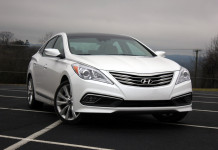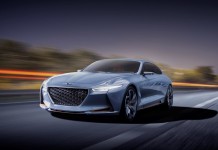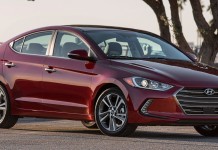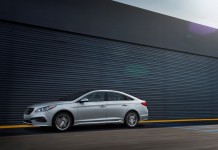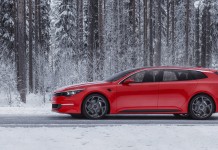“Engineered for whatever.” Not too long ago, Hyundai Motor America set out to build a vehicle that could become the ultimate anything car. With their targets set on the young and active demographic, they began building something that would be athletic, efficient and useful all while actually being something special. What resulted isn’t just another hatchback, coupe or sedan but a combination of all of the above. Billed by Hyundai themselves as an “Advanced Technology Three Door-Coupe”, the 2012 Veloster might actually be able to do anything, whatever and all of the above.
Riding on an all-new chassis, the Veloster is placed right between the subcompact Accent and larger Elantra. The front wheel drive layout is similarly sized to Honda’s CR-Z and Scion’s tC. Those two cars are Hyundai’s main rivals for their new coupe but its dimensions alone could put it up against the Volkswagen Beetle, Mini Cooper and Fiat 500. They all share similar philosophies: posh styling, space-saving construction, small but efficient powertrains and loads of technology. In order to determine if the Veloster carries all of those things and more, we traveled to the sunning coast of Florida to Saint Pete Beach so the latest Hyundai could show that it has what it takes to be honestly unique.

Hyundai hopes to attract an all-new breed of buyers with the Veloster as it combines the tidy dynamics of the Accent with the more upscale features found on the Elantra. Looking at outward appearances alone, the attraction is there. Taking many cues from the world of motorcycles, the “Fluidic Designed” outside is modeled after a rider’s helmet while the inside is inspired by sleek superbikes. The front adopts Hyundai’s hexagonal grille which meshes just right with the low-slung and assertive bumper. Housed inside the massive headlamps are LED accents to give the front an upscale feel. The long hood features subtle vents, adding to the youth-oriented aggression. Moving alongside the profile and to the rear, the Veloster looks like a much stronger and more muscular CR-Z. Carrying massive fender flares and wraparound tail lights, the tapered back features a short overhang and a stylish center exhaust. Arguably the most unique feature of the vehicle is its passenger side third door. With a flush and hidden handle, the subtle feature adds to the useability of the Veloster as it ditches to task of folding the front seats to access the rear. Overall, it is a handsome little car, especially bathed in Vitamin C clothes such as our main tester.




Starting out, the Veloster is available in six differently priced trims. There are three packages: Base, Style, and Technology as well as two transmission options. Standard features for the car are diverse and include 17 inch wheels, XM radio with USB auxiliary jacks, Bluetooth hands free phone system with voice recognition, Blue Link telematics system, and a seven inch LCD media display with touchscreen control. MSRP for a base six speed manual is $17,300; the lowest priced Veloster currently offered. To get the optional and all-new, Hyundai built six speed dual clutch automatic, $18,550 must be spent. The styling package which includes 18 inch wheels, fog lights, a Dimension’s supplied stereo with subwoofer and panoramic sunroof costs an additional $2,000. The technology package adds everything on the styling package plus painted 18 inch wheels, backup camera and warning sensors, a 115 volt outlet, push button start and navigation. For $4,000 extra, a loaded-out Veloster with the dual clutch transmission carries an MSRP of $22,550.
Under the hood of every first run car is Hyundai’s 1.6 liter, DOHC gasoline direct injected inline four cylinder. This all alloy engine features variable valve timing to produce 138 horsepower and 123 lb-ft of torque. Basically pulled straight from the Accent, the 1.6 GDI was designed for a long life and high fuel mileage. A timing chain accompanies light weight materials so that when equipped with the six speed manual, the Veloster becomes a offical member of the 40 mpg club. The powertrain may be efficient but a lot of the high economy can be attributed to the car’s light curb weight of just 2,584 lbs of the manual. If do-it-yourself shifting isn’t your thing, than economy doesn’t falter too much when equipped with the dual clutch automatic. More than likely due to its slightly higher curb weight, the DCT Veloster should average 38 mpg on the freeway. Built entirely in-house, the DCT is a first for Hyundai and features two dry clutches, one for the odd gears and one for the evens. A manual shift mode is available as well as steering wheel mounted paddle shifters.
We spent the majority of our time bonding with a base six speed manual. Despite not having the tech package’s navigation, premium stereo or 18 inch wheels, the base car is still loaded with neat features. The seven inch screen is crisp and responsive with loads of customization. Background colors, images and tones can all be modified and the menus and submenus are easy to navigate. There are even two ‘games’ that can be played to track fuel economy. One of which, entitled “Blue Max”, scores your driving for 10 minutes and gives higher points the more efficiently the Veloster is driven. Available without the navigation is real time weather, sports and stock reports. Able to entertain simply by standing still, the Hyundai doesn’t disappoint when things begin to move. The clutch is light and easy, making the Veloster a breeze to drive. Despite lacking the abnormal precision of a Honda shifter, the six speed offers quick engagements and short movements into every gear. Rowing through those gears will have to be done often as the 1.6 liter engine isn’t very torque-filled. Low-end grunt could be improved but when revved hard, the Veloster can put a smile on a driver’s face. After 3,500 rpms, the GDI will sing to redline and hold pace with relative ease. Highway passing does require the occasional downshift, especially when placed in sixth gear. The placement of the steering wheel, gearshifter and pedals make for a “grab-and-go” driving experience. Large stabilizer bars (24mm front, 23mm rear) mean body roll is almost non-existent. The steering, which is aided by an electric assist, is initially strange as the wheel never seems to want to be off-center. Perhaps over-boosted, a revamp could make parking lot speeds feel more connected. Inputs are however right-now quick allowing for sweeping freeway on ramps to be tackled with haste and confidence. Even though the rear features a torsion beam, the Veloster is stable and precise in its movements.
As a base model, the Veloster is a very charming vehicle. It could be more powerful and the steering could be less robotic at low speeds, but those grips can be addressed with an additional engine option and a slight revamp. When equipped with the tech package, the Hyundai’s “cool” factor does increase ten-fold. In addition to the base car, we managed to sample a loaded DCT model to find the optional navigation to be excellent. Offering turn-by-turn directions and a Zagat-rated restaurant guide, the Blue-Link equipped system can all be navigated via voice recognition. Smartphone users can benefit from the tech package further as videos and photos can be displayed on the screen as well as Pandora internet radio. These features alone might validate the extra cost, but some added items could be done without.

Even though they may look cool, the larger 18 inch wheels do not do the Veloster’s chassis any good. When equipped, the ride becomes choppy and the car never seems to settle down. The smaller 17 inch wheels suit the car better just as much as the six speed manual. Not a bad transmission at all, the DCT just doesn’t seem to match the Veloster’s personality as well. Upshifts are glass smooth but downshifting and initial take off can get jarring. And even when put in manual mode, the DCT feels the need to upshift when the engine meets its redline.
Hyundai might be taking a risk with the Veloster, but all the ingredients are present to make for a success story. It’s spacious, efficient (we did break 40 mpg on the highway), fun and packed with technology usually reserved for vehicles twice its price. The innovated third door is useful, relinquishing the awkward access usually associated with coupes. Every piece of material used on the inside screams quality and none of the Hyundai’s competitors can match its standard warranty. Any initial complaints about the engine’s peaky nature can be silenced with a more powerful, optional engine choice. If history does actually repeat itself, an R-Spec version could be in the cards for the next model year. Even if that isn’t the case, the 1.6 version will still captivate with its unexampled styling, precise dynamics and efficient nature. Able to do many things and do them well, the 2012 Veloster truly is, as Hyundai puts it, “engineered for whatever.”












